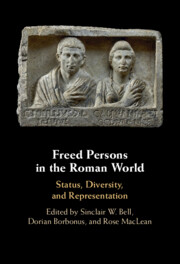43 results
48 - Constitutional Courts and Supreme Courts
- from Part III D - The Legal System
-
-
- Book:
- The Cambridge Handbook of Constitutional Theory
- Published online:
- 27 March 2025
- Print publication:
- 24 April 2025, pp 848-866
-
- Chapter
- Export citation
Lost and found: dynamics of relationship and employment status over time in people with affective and psychotic spectrum disorders
-
- Journal:
- BJPsych Open / Volume 11 / Issue 1 / January 2025
- Published online by Cambridge University Press:
- 26 December 2024, e11
-
- Article
-
- You have access
- Open access
- HTML
- Export citation
2 - Imaginaries of Prosperity
-
- Book:
- Reimagining Prosperity
- Published online:
- 18 October 2024
- Print publication:
- 21 November 2024, pp 20-71
-
- Chapter
-
- You have access
- Open access
- HTML
- Export citation

Freed Persons in the Roman World
- Status, Diversity, and Representation
-
- Published online:
- 16 May 2024
- Print publication:
- 23 May 2024
Fewer obligations for welfare recipients, more social and economic activities? Results from an experiment with less conditional welfare regimes
-
- Journal:
- Journal of Social Policy / Volume 54 / Issue 2 / April 2025
- Published online by Cambridge University Press:
- 23 November 2023, pp. 374-391
- Print publication:
- April 2025
-
- Article
-
- You have access
- Open access
- HTML
- Export citation
Chapter 2 - How Social Relationships Matter for Health
-
- Book:
- Relational Health
- Published online:
- 23 February 2023
- Print publication:
- 02 March 2023, pp 20-40
-
- Chapter
- Export citation
Precarious work: Economic, sociological and political perspectives
-
- Journal:
- The Economic and Labour Relations Review / Volume 24 / Issue 3 / September 2013
- Published online by Cambridge University Press:
- 01 January 2023, pp. 263-278
-
- Article
- Export citation
Chapter 9 - Durkheim: Solidarity, Moral Facts, and Social Pathology
-
- Book:
- Diagnosing Social Pathology
- Published online:
- 07 October 2022
- Print publication:
- 27 October 2022, pp 192-228
-
- Chapter
- Export citation
Art therapy focused on stimulating the emotional and expressive skills of the atypical children
-
- Journal:
- European Psychiatry / Volume 65 / Issue S1 / June 2022
- Published online by Cambridge University Press:
- 01 September 2022, pp. S236-S237
-
- Article
-
- You have access
- Open access
- Export citation
Dissemination of sport-based psychosocial interventions in Europe: results from the EASMH project
-
- Journal:
- European Psychiatry / Volume 65 / Issue S1 / June 2022
- Published online by Cambridge University Press:
- 01 September 2022, p. S318
-
- Article
-
- You have access
- Open access
- Export citation
10 - European Union Citizenship
- from Part III - Rights of Movement and Residence in the EU
-
- Book:
- EU Law
- Published online:
- 14 July 2022
- Print publication:
- 14 July 2022, pp 361-414
-
- Chapter
- Export citation
3 - Integrating without a Host Society
- from Part I - The Postwar and Decolonization Moment
-
-
- Book:
- Refugee Crises, 1945-2000
- Published online:
- 13 October 2023
- Print publication:
- 01 October 2020, pp 55-82
-
- Chapter
- Export citation
1 - Introduction
-
- Book:
- Language Development and Social Integration of Students with English as an Additional Language
- Published online:
- 03 July 2020
- Print publication:
- 16 July 2020, pp 1-22
-
- Chapter
- Export citation
Loneliness and social integration as mediators between physical pain and suicidal ideation among elderly men
-
- Journal:
- International Psychogeriatrics / Volume 33 / Issue 5 / May 2021
- Published online by Cambridge University Press:
- 09 July 2020, pp. 453-459
-
- Article
-
- You have access
- Open access
- HTML
- Export citation
19 - Social Relationships and Cognitive Development in Adulthood
- from Part III - Aging in a Socioemotional Context
-
-
- Book:
- The Cambridge Handbook of Cognitive Aging
- Published online:
- 28 May 2020
- Print publication:
- 28 May 2020, pp 350-366
-
- Chapter
- Export citation
Social integration and the quality of life of schizophrenic patients in different types of complementary care
-
- Journal:
- European Psychiatry / Volume 15 / Issue 8 / December 2000
- Published online by Cambridge University Press:
- 16 April 2020, pp. 450-460
-
- Article
- Export citation
Assessing social integration in the elderly: development of a brief self-report assessment scale: the social integration and independence questionnaire
-
- Journal:
- European Psychiatry / Volume 7 / Issue 3 / 1992
- Published online by Cambridge University Press:
- 16 April 2020, pp. 115-120
-
- Article
- Export citation
7 - Migration and Integration
- from Part III - Hard Choices
-
- Book:
- Migration and Integration
- Published online:
- 15 November 2019
- Print publication:
- 21 November 2019, pp 155-173
-
- Chapter
- Export citation
Caractéristiques environnementales favorisant la participation sociale: une enquête auprès d’aînés québécois
-
- Journal:
- Canadian Journal on Aging / La Revue canadienne du vieillissement / Volume 39 / Issue 1 / March 2020
- Published online by Cambridge University Press:
- 30 July 2019, pp. 1-11
-
- Article
-
- You have access
- HTML
- Export citation
Residencia posmarital, movilidad y relaciones sociales en el Área Andina Centro-Sur
-
- Journal:
- Latin American Antiquity / Volume 30 / Issue 3 / September 2019
- Published online by Cambridge University Press:
- 05 July 2019, pp. 459-470
- Print publication:
- September 2019
-
- Article
- Export citation




